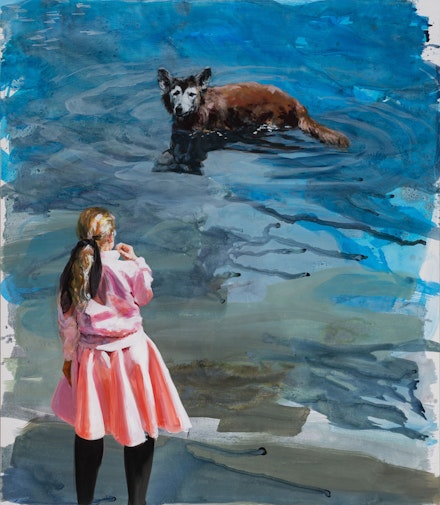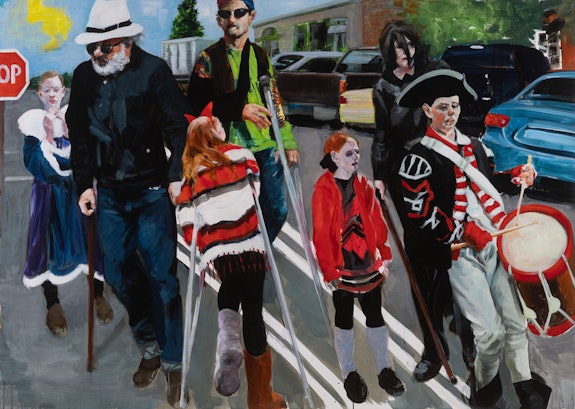ArtSeen
Eric Fischl: Towards the End of an Astonishing Beauty: An Elegy to Sag Harbor, and thus America

On View
Skarstedt GallerySeptember 14–October 29, 2022
New York
Eight large acrylic paintings on linen (all but one 65 by 75 inches or larger)—eight stunning examples of psychological art that seize the viewer’s imagination and put it to work. In the case of Eric Fischl, “psychological” means a painterly style works through a mental Gestalt process: instead of our eye completing a broken line as it would in a Gestalt experiment, it is our minds that complete Fischl’s works. We see the scene and instantly begin to ascribe characteristics to Fischl’s characters, but, naturally, our inventions have little to do with the artist’s own thoughts or intentions. This has always been the case, as Fischl’s work is conspicuously open-ended, always on the verge of narrative but never actually turning into illustration or allegory.
These paintings are Fischl’s response to experience. We cannot call that experience history because history is a narrative that seeks to give meaning—a beginning, a middle, and an end—to events and experiences. Fischl leaves that to his interpreters, who of course impose their own points of view on his work. It’s fair to say that Fischl is an autobiographical artist, so long as we understand his autobiography as a tentative work-in-progress, heavily redacted, always subject to change without notice. All he asks of us is that we study his scenes carefully, suspending judgment or even interpretation until we’ve allowed each work to leave its mark on us. We must surrender ourselves to the image and let it live within us.

The show currently on view at Skarstedt Gallery, whose very title is charged with melancholy, is ultimately about bereavement: something or someone we cherish is irrevocably torn away from us, leaving a hole in our hearts. What things? Let’s begin with innocence. The first work here depicts a small girl, her back to us as she watches a dog frolic in a pond. The dog is having the time of his life; the girl, insofar as we can know, exults in its joy. But their experience is ephemeral, not merely because they will forget and because all joy is ephemeral, but because they lack the means to preserve it. A photo would do nothing more than document the situation, while Fischl’s painting puts us in the scene, not as mere spectators but as both participants and commemorators. And naturally we can only commemorate what no longer exists.
Sign of the Times (2022) is a complex and enigmatic composition. Our visual focus is on a figure we assume to be feminine, dressed in a flowing pinkish dress. Perhaps she’s ready to party, we think, until we notice a paint brush clutched in her right hand. So, she’s painting the sign held up for her by a zombie-like man. She and her collaborator are warning us: “PREPARE FOR THIS LIFE TO END SOON.” The other characters in the painting, a bored blond immersed in her own quandaries, a man who seems to have forgotten he’s dead, and a faceless character who resembles No Face from the 2007 animated film Spirited Away. An enigmatic character, he absorbs the personalities of others: perhaps here we encounter Fischl’s metaphorical self-portrait, since we know that the origin of these paintings, like so much of his work, is photography, an art often believed to rob its subjects of their souls. Life does end forever unless preserved, as it is here, in paint.

The Parade Returns (2022) takes us back to the town of Sag Harbor, which Fischl highlights in the title of the exhibition. COVID-19 cancelled the Ragamuffin Parade that traditionally takes place there on or near Halloween, but Fischl brings it back, not with witches and goblins but with a disabled child limping along on her crutches and, walking in the opposite direction, a drummer in colonial costume who looks as if he abandoned his grave to participate. The pandemic may be receding in public consciousness, but, Fischl suggests, we are not back to anything like normalcy. The distant past is a utopia from which we expunge nightmares, the recent past is a nightmare, and (with apologies to Stephen Dedalus) it’s a nightmare from which we have yet to awaken. A Boy’s Life (2022) brings that reality home with a vengeance. Here, a family is decked out for the parade: Mom and Dad are in clown costume and their boy is tricked out as a devil. But they are sullen and withdrawn, especially the boy, who occupies center stage. COVID isn’t the only infection here: there is a malaise among us only Eric Fischl could capture in paint.

